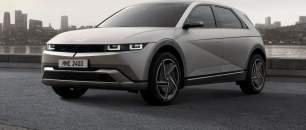Hyundai claims the RWD Ioniq 6 Dynamiq will accelerate from 0-100km/h in 7.4 seconds, which is not hanging around, and it feels every bit that quick.
In fact, it has more than enough performance for sharp response in the city and easy cruising on the highway.
Step up to the AWD Techniq or Epiq and you’re hitting 100km/h in just 5.1 seconds, which is properly rapid.
A single-speed ‘shift-by-wire’ reduction gear auto transmission sits on the rear or both axles and you have the choice of ‘Normal’, ‘Eco’, ‘Sport’ and ‘Custom’ drive modes, which fine-tune power output, accelerator response, steering weight as well as power distribution between the axles on AWD models.
Hyundai’s ‘E-Active Sound Design’ (e-ASD) changes the ‘sound texture’ as you drive with a noise roughly approximating Luke Skywalker’s Landspeeder coming through the speakers.
It’s fun for a while, but I found myself turning it down, then off, for the majority of the launch drive. And in that silent mode you can feel and hear (or not?) the impact of the car’s super-slippery shape. No wind noise and only modest tyre rumble at 110km/h on the freeway.
The Ioniq 6 sits on Hyundai’s ‘Electric Global Modular Platform’ (E-GMP) which features the flat battery pack mounted low down, skateboard-style, between the axles.
Suspension is strut front, five-link rear, and although the set-up hasn’t been tuned locally, Hyundai Australia says it’s been involved in the development.
The front seat remained comfy after hours behind the wheel, but it must be said bumps and thumps from typical highway surfaces made their presence felt on a regular basis.
That’s not unusual for a full electric vehicle, but with the RWD Dynamiq riding on relatively cushy Hankook 225/55 ventus S1 evo3 rubber, it’s surprising.
In corners you can feel the effect of the car’s low centre of gravity with the battery and motor(s) mounted low in the chassis. It hunkers down and remains beautifully balanced and secure through sweeping bends.
But even though the car points nicely, a meaningful connection between the front tyres and your hands on the steering wheel is MIA.
The physical brakes are vented discs at the front and solid rotors at the rear, adjustable through ‘Normal’ and ‘Sport’ settings, and they’re nice and progressive.
However, there’s more fun to be had with the regenerative braking, adjustable through three levels (‘Strong’, ‘Medium’, ‘Soft’) via steering wheel-mounted paddle shifters.
Move to the highest setting and you’re in ‘i-Pedal’ mode which means for the majority of the time easing off the accelerator is all that’s required to wash off speed before coming to a reasonably prompt halt.
In terms of ergonomics, the simple dash layout works well thanks to a sensible mix of digital and physical controls, the head-up display is crystal clear, and the big screens for media and instrumentation are hard to fault.
A word of warning, though. An over-speed chime fires four times when you even marginally exceed the detected limit. It quickly becomes intensely annoying, the saviour being an off button in the vehicle settings menu. Downside is it defaults to ‘on’ every time you stop and re-start the car. Ugh!

